There’s not much that’s more exciting than bringing your new furry companion home! You’ve bought the food bowls, the toys, and a super expensive bed that they’ll never use, and now it’s time to welcome your newest family member. But how do you even begin deciding which breed of dog is perfect for you? There are hundreds of breeds of dogs and each one has its own unique personality, temperament, and health
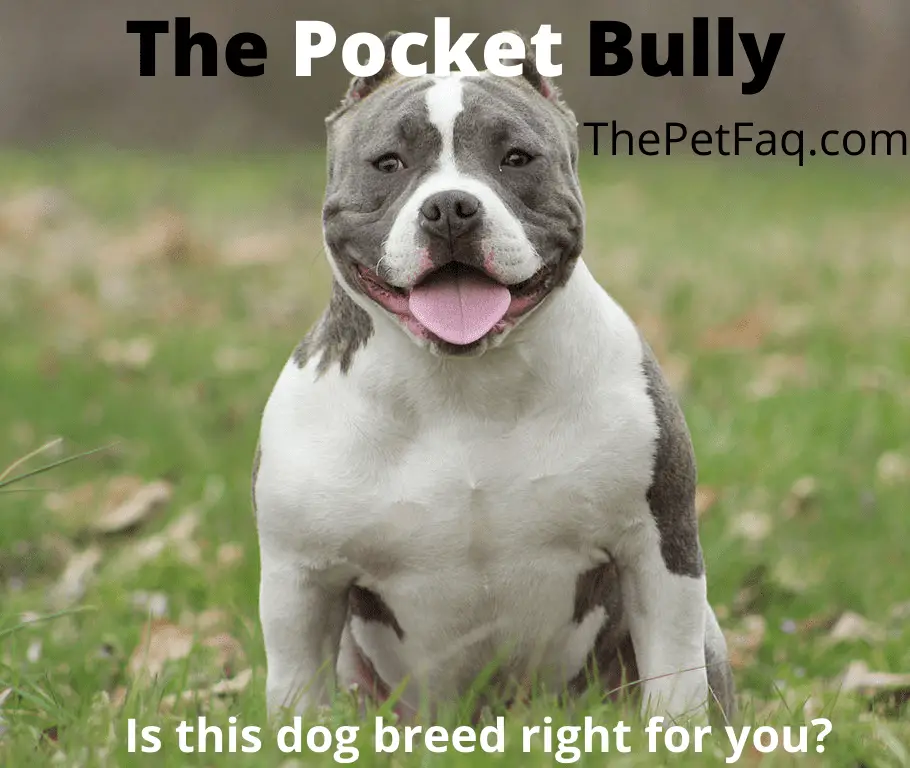
The American Pocket Bully is an absolutely wonderful family pet and an intelligent, affectionate breed as well. We’ll discuss the breed’s history, appearance, and temperament, and provide you with the information you need to decide if a Pocket Bully is the right choice for you.
Origins of the Pocket bully
It is quite confusing to understand the differences between all the bully breeds and how each one came about, but the earliest accounts of the pit bull breed are in ancient Greece. Needed as war dogs for their muscular builds and strong jaws, they eventually headed to the colosseum where they became entertainment. From there, they moved across Europe and became “baiters” for bulls, by biting them on the nose to distract them from their human handlers. It was when the breed crossed over into England, that they began to earn their infamous reputation. Starved and abused, pit bulls and other bully breeds were used for dogfighting and ratting in pits, which is where the name “pitbull” comes from. Unfortunately, dog fighting became popular in the late 1800s in America when the pitbull breeds crossed over to the US.
From there, after dog fighting was banned, people began to take more of an interest in the pitbull for more than just fighting. Unable to shake their violent pasts, breeders decided to cross different bully breeds to develop desirable traits and rewrite the public’s opinions about bully breeds. Emerging in the 1980s, it wouldn’t be until 2004 that the American Bully Kennel Club would recognize it as a breed separate from Pitbulls.
There is a bit of argument of which breeds were actually crossed to create the Pocket Bully, but the general consensus is a mix between the Patterdale Terrier and The American Pit Bull Terrier, or a mix between The American Pit Bull Terrier and The American Staffordshire Terrier. Both mixes created a Bully that was sweet, loyal, and lacking in aggressive tendencies. While still a relatively new breed, American Pocket Bullies are growing in popularity for their goofy personalities and sweet temperaments.
Appearance of the Pocket bully 🐕
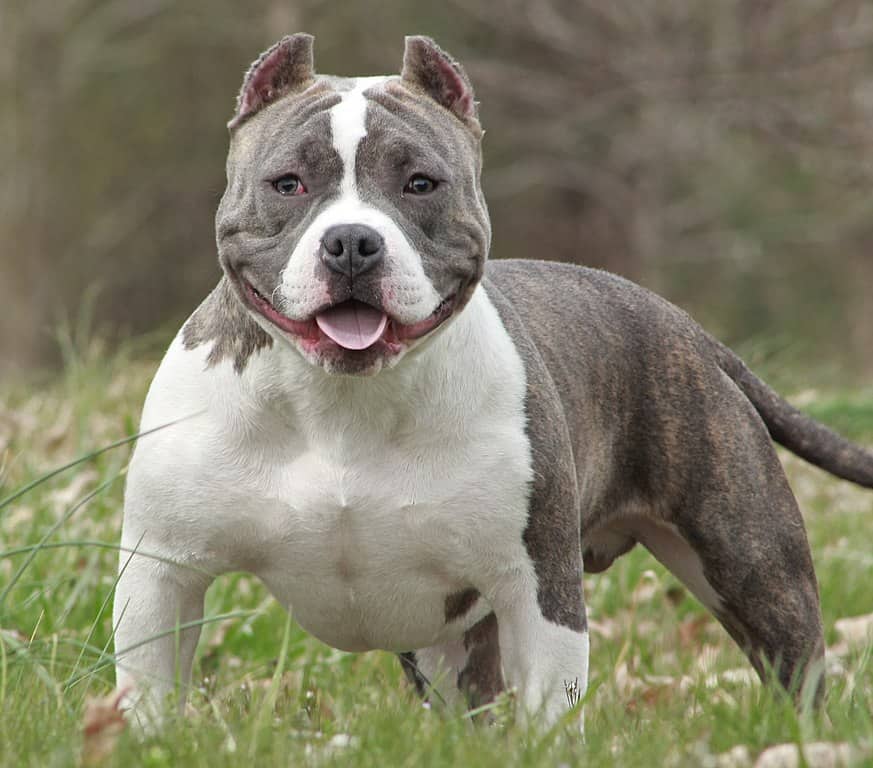
While often confused with its cousin, the American Pit Bull Terrier, American Pocket Bullies are actually their own breed with distinct physical traits. It can be very confusing to tell the difference between the bully breeds and especially among the Pitbull and Pocket Bully but the main difference is weight and muscle structure.
The easiest way to identify a Pocket Bully is by looking for a large barrel chest with a short, muscular frame. Think of a cross between a Pitbull and an English bulldog, which is one of the crosses used to create the bully, and you can picture the short, bulldog frame with the classic Pitbull face.
Just like breeds come in different colors, they can also come in different sizes. The standard categories for the American Bully are Pocket, Standard, Classic, and XL, which are separated by height, not weight. The Pocket is the smallest but still packs a lot of muscle on their short frames. Pocket Bullies can range from 25-120 pounds and range from 13-17 inches high at the shoulder.
A Bully should have a large head and a square jaw with drooping skin around the mouth, which is how they make that classic smile that everyone adores. Their bodies should taper down from the head back to powerful, short legs. The most distinctive physical trait of these dogs is their large barrel chests. Built for power, Bully’s chests are broad and muscular. Don’t let their muscular chests fool you though, these guys are nothing but big love bugs.
Pocket Bully Colors
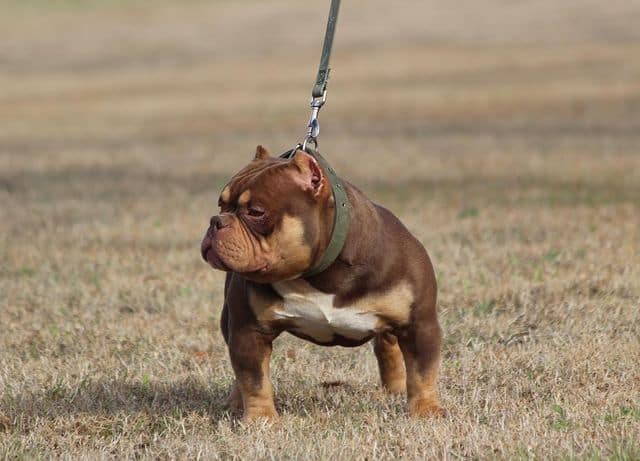
Pocket bullies can have many different colors. Red-nose and blue-nose bullies are amongst the most popular and are a reference to the color of the dog, not their noses. The next most common is fawn, which is a light brown or brown color and can have white mixed in. Not to be confused, brindle and striped refer to different coat patterns, with the brindle being the most recognizable.
Perhaps the most visually pleasing though are the tri-color bullies. They were recently considered rare colors but responsible breeders have been able to identify the recessive gene that creates the tri-color. With unusual names such as “lilac” and “tri choco”, you may think you’ll see a purple dog or one made of chocolate! Lilac coats refer to a lighter, almost silvery coat and are highly sought after. A tri choco is a coat that has differing shades of brown and is quite striking.
An important note though, in order to be considered a tri-color pocket bully, the breed must also have the minimum proportions of the pocket bully as having three colors is not enough. On that note, if you’re looking to show your bully, albinism and merle coats are not accepted.
Temperament of the Pocket Bully
With their fearsome reputations from their Pitbull cousins and muscular appearances, American Pocket bullies give off an intimidating image. This breed was created to bring the more loving traits of the Pitbull to the forefront and try to rebrand the Pitbull’s image.
Famous for their goofy smiles, Pocket bullies are also incredibly loving, loyal, and great with kids. Yes, in fact, most bully breeds are considered “nanny” dogs as they love children while also remaining intensely protective of them. They have a high tolerance when it comes to small children grabbing and climbing over them and are content to lay by their sides during movie time. While you should never leave any dog along with a small child, bullies are perfect for families with children.
Like any animal, they can be aggressive if mistreated, isolated, or used for fighting, which is illegal but still happens. The UKC disqualifies any American Bully that is aggressive or shows signs of shyness, as they are bred for their docile natures and confident attitudes.
bullies possess sweet temperaments and are not natural guard dogs. They will protect their loved ones fiercely but will not pick fights or attack as they would much rather be curled up in your bed with you. Full of energy and a curious nature, these softies will enjoy spending time playing with your children or going for relaxing walks around the neighborhood. If you’re looking for a sweet, cuddly dog who is also great with kids, the American Pocket Bully is perfect for you and your family.
Training a Pocket Bully
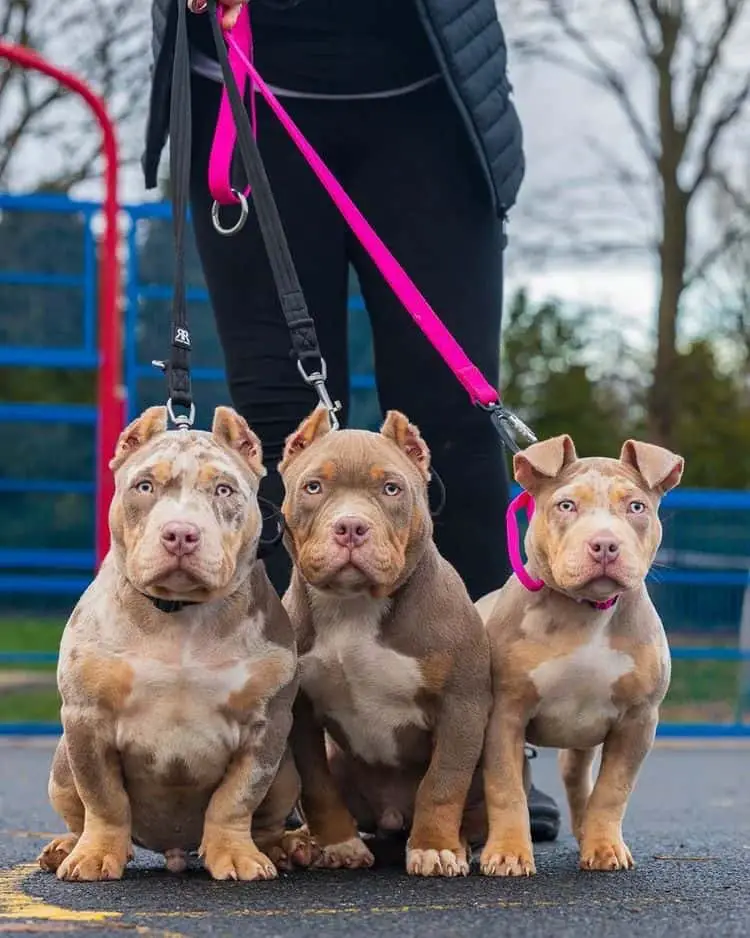
When bringing any puppy or new dog into your home, it is important to begin training right away and use positive reinforcement training. This simply means to reward good behavior and ignore bad behavior. With bullies being loyal and eager to please their owners, training these dogs will be rewarding for you both. All training sessions should be 10-15 minutes as the attention spans of puppies are limited. Daily practice of common skills such as sit, come, lay down, and stay will ensure your Bully will be a well-behaved dog quickly.
As an intelligent breed, American Pocket bullies will pick up on simple commands quickly and soon look for more challenges. Every individual dog is different though, and while bullies are known to be easy to train, they can be difficult, much like their English Bulldog ancestors. Always have patience when training your new puppy and remember they’re just learning too.
Built for athleticism, Pocket bullies will excel in dog competitions and hardy walks with their owners. Agility, flirt pole, and fetch are always fun for both you and your dog and also mentally stimulating for your pup. A large portion of pet owners are unaware that our canine companions need both physical and mental stimulation to lead fulfilling lives. A bored dog can lead to destructive behaviors and even anxiety.
Keeping your Bully mentally stimulated is much easier than you think and can involve harder tricks to learn, puzzle toys, and sniffing games. They’ll be fun for your pup and offer excellent bonding time as bullies love to be around their families as much as possible.
Exercise
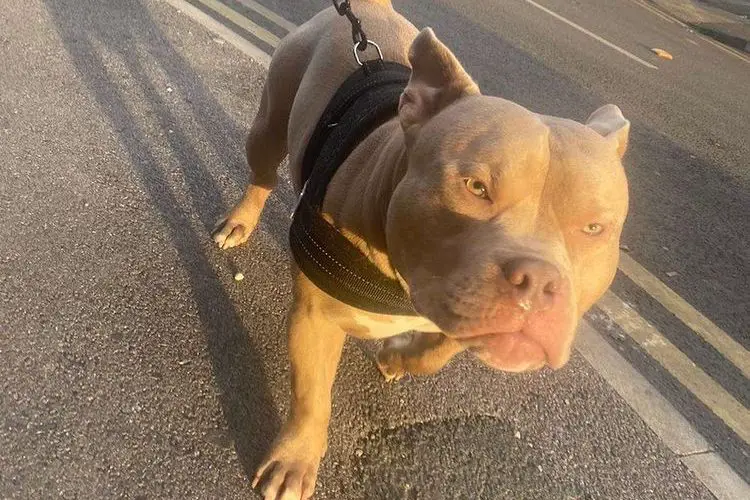
All dogs require daily physical exercise. Depending on which breed you choose to bring into your home, they will have different physical requirements. American Pocket bullies fall into the high energy category, which can vary from dog to dog, and will require at least 30-60 minutes of physical exercise a day.
This can include a long walk around the neighborhood at a moderate pace or a good game of fetch in the backyard with lots of jumping and catching. By far one of the best places for you and your pup to go is the dog park. While dog parks can have bad reputations, finding one that is a positive, welcoming space is essential for your pup. If you cannot find or don’t feel comfortable at a dog park, consider finding a playmate for your pup or going to doggie daycare.
Dogs are highly social animals and bullies are exceptionally so. While they remain loyal to you and your family, they also love to explore and play with their canine friends. Not much is more joyful than watching two dogs play together and tire one another out! This serves to both mentally and physically relax your pup as they’ve been able to play, socialize, and move about.
If you find yourself with a smaller living space, that is perfectly acceptable. As long as you make it a part of your dog’s daily routine to receive exercise, they’ll be happy to snuggle the night away. Be careful though if you live in colder temperatures, as a Bully’s coat is shorter and not suited for freezing cold weather. They do look absolutely adorable in sweaters though and can enjoy being outside while looking stylish.
Grooming a Pocket Bully ✂️
Often referred to as a “velvet hippo” for how sleek they look, the grooming needs of the Pocket Bully are considered low maintenance due to their short coats. Weekly brushing of your Bully is helpful for several reasons. It helps to keep your pet’s coat smooth and clean, reduces shedding, and is a great way to bond with your pet. Finding a good brush is important and with a little research, there are many options perfect for the Bully’s coarser coat.
Each pet is different and some dogs love the bath while others create a commotion if they even hear the water running. It is important from an early age to begin bathing your puppy and reward them for their good behavior in the bathtub. If you’ve brought an adult Bully into your home, it’ll be some trial and error before you both figure out how bath time is going to work!
A Pocket Bully only requires a bath every 8 or so weeks, as long as they didn’t roll in a delightful smell which is probably not so great to us. Overwashing a dog is unhealthy for their coats as it breaks down the natural oils that protect their skin and can lead to dry, itchy skin. Bath time should include a good oatmeal-based shampoo, scrubbing with a soft rag, and lots of treats to ensure a good time for all.
While daunting, a dog’s nails do need to be trimmed. Everyone has heard about the dreaded quick of the nail and causing their furry friend pain. While this is a concern, with some research and talking to your vet, you can confidently trim your pup’s nails without the fear of causing them pain. When starting out with a puppy, handle their paws frequently to help them adjust to their paws being touched.
Other grooming needs include cleaning their ears and eyes regularly and brushing their teeth twice a week. Smaller bully breeds, like the Pocket Bully, are prone to periodontal diseases which are painful for your pet and an expensive trip to the vet.
Diet 🥩
- ⭐High-quality dog food
- ⭐High protein
- ⭐Raw food
Much like humans, a dog’s diet changes as they grow from puppyhood to adulthood. When bringing your new Bully home, be sure to feed them three times a day with a high protein and fat kibble that is suitable for their age. Puppies will consume more food as they are growing and slow down when they hit adulthood.
It is important that bullies receive high protein diets as they are a muscular breed and need to maintain their body weight and muscle mass. Researching food brands is highly important and it is possible to find quality food within any budget.
A popular choice is to feed your dog a raw food diet. This is perfectly healthy, and while a bit more expensive, is quite good for your pet. Raw foods include chicken necks, salmon, and yogurt, all of which will help your pet’s immune system and benefit their coats. You should always discuss with the breeder or your vet before introducing a raw food diet though, as your pup may be too young or have breed-specific sensitivities.
There is always the option of making your pet’s food at home! This is a simple, convenient, and often cheaper option, as you can use what you have around your home. Dogs love meat stews, raw bones, and porridge. Be sure though that your pet is receiving all the proper nutrients from their diets as this can lead to health and behavioral problems if they are not.
Not many people are aware that a dog’s diet directly affects their physical and mental health. A proper diet ensures your pet’s coat, skin, and physical and mental health are in top shape. Dogs are prone to developing anxiety disorders, destructive behaviors, and the Pocket Bully is no different. Speak with your vet or breeder to ensure that your Bully’s diet is where it should be and immediately ask questions if something is physically wrong or seems off about your pet.
Health of the Pocket Bully 💊
All dog breeds have specific genetic health issues and it is imperative that you are aware of those issues. Since Pocket Bullies are still a newer breed, having been created within the last 30 years, people are still figuring out what their pedigree health issues are.
Generally speaking, Pocket Bullies are strong and healthy dogs that do not suffer from many ailments. So far, these health issues have been observed in Pocket Bullies:
- Hypothyroidism: This disease develops later in a dog’s life and symptoms include obesity, skin problems, and slow heart rate.
- Hip Dysplasia: A very common issue in all dog breeds, this is painful for your Bully and can only be fixed via physical therapy or surgery.
- Eye Problems: Pocket bullies are prone to Cherry eye, Dry eye, Pink Eye and Cataracts.
Some health issues cannot be avoided, like Hip Dysplasia, but checking your pet daily for unusual signs or symptoms can help catch diseases in the early stages. A proper diet, adequate exercise, and affection can keep your dog happy and healthy both mentally and physically.
Price of a Pocket Bully Puppy

When deciding to bring a Bully puppy home, beware. There are many disreputable breeders who will try and sell puppies that are not actually American Bullies. Always request to meet the parents and be prepared to ask questions regarding their bloodlines, health, and temperaments. Good breeders can help you best understand your new dog and you’ll be guaranteed a healthy, happy pup.
The most expensive Bully in the world sold for $500,000 dollars. The dog breeding world is highly competitive and with the breed becoming extremely popular, the prices will reflect that. Depending on their bloodlines and coloring, Pocket Bully puppy prices can vary. Starting at around $1,000, those prices go up the more unique the color and how many champions are in their bloodlines. Be prepared to spend at least $2,000 on a Bully puppy from a professional kennel, which will include a bill of health and sometimes, life-long assistance for your new companion.
Final words
Pitbulls and their relations have had a bad reputation for far too long. Bred for their sweetness and loyalty, American Pocket Bullies are well on their way to re-writing Pitbull and Bully breed history. Welcoming this breed into your life not only ensures you’ll have a loving, cuddly pet but also helps erase the stigma around bully breeds.
Truly fit for families with children, they’ll bring laughter into your home and silly antics as they play with your children. Once the children are asleep, you’ll be able to enjoy those snuggles as Pocket Bullies are highly affectionate and wish to be as close as they can to you. Easy to groom and without too demanding of physical exercise, these dogs fit perfectly into any family who is willing to open their heart. Go browse pictures and fall in love with the American Pocket Bully’s smile just as we have!
- How Long Do American Eskimo Dogs Live? Important Factors and Care Tips - September 29, 2023
- Do American Bulldogs Need Grooming? Essential Tips and Care Guidelines - September 29, 2023
- Do Bengal Cats Enjoy Playing? Essential Tips for Keeping Them Active - September 29, 2023